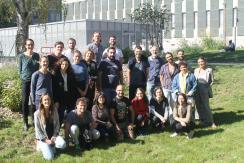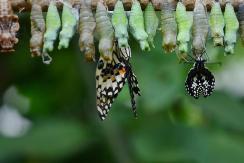COEVOL Multi-Scale Coevolution
Living systems are highly integrated, with a multitude of levels of organization, from molecular and intra-cellular scales to ecosystems. Complex organisms are themselves consortia of macro- and micro-organisms, which work together with their host to build the individual. Yet, each of these organisms can function and evolve in the short term according to its own logic, possibly in conflict with other higher or lower levels, or with other time scales. The once common idea among evolutionists that natural selection results in organisms perfectly adapted to their environment is now severely undermined. Not only because, as the Red Queen explains to Alice, one has to run relentlessly to keep its place in a changing environment, or because past evolutionary history and chance constrain the possibilities of present adaptation, but also because different levels of selection have interests that are generally difficult to reconcile.
Multi-scale coevolution resets classical questions in evolutionary biology
One example, of particular interest is the question of the source of heritable variations. The phenotype of organisms in a population is influenced not only by variations in their nuclear and mitochondrial genomes, the dynamics of which is the object of population genetics, but also more and more patently by the consortium of microbes and genetic elements that constitute its microbiome and virome. The hologenome designates this complex assembly of genetic materials, which obey different rules of transmission and different evolutionary strategies. The ability of symbionts to manipulate host phenotypes or to interfere with each other influences the evolutionary dynamics of all players in ways that are yet poorly understood. In addition, new questions arise, such as the importance of co-adaptation in these systems and their consequences in maintaining cohesive biological systems.
- Symbiosis: a response to and a source of divergent selection
Using a variety of approaches combining experimental evolution, genomic, functional, phenotypic and behavioral data, we aim to test whether symbiosis facilitates diversification and to characterize the underlying microevolutionary processes.
- Ecological networks of horizontal gene transfer
We develop original methods to detect gene transfer and we investigate the factors that influence the routes of gene transfers among microbes but also among insects.
- The interplay between symbiosis, infection and immunity and its evolutionary consequences
We try to understand the intimate interaction of hosts with pathogens, symbionts and transposable elements and how it affects the extended phenotype of the host.
- Transgenerational inheritance and environment changes
We try to decipher the molecular mechanisms that underlie rapid adaptation to environment and to test for transgenerational inheritance of fitness traits.
- Intragenomic conflicts and demography
We are developing models to test whether changes in the demography of the host affect the dynamics of transposable elements.
- The determinism of phenotypic convergence
We study the genomic basis of convergent phenotypic evolution in particular in the case of animals and plants adaptation to increasing temperature and decreasing water.
- Reconciling the tree of life
We develop phylogenetic methods for “reconciling” gene/species or host/symbiont histories and use these methods to explore the bulk of extinct or undescribed species and the history of association of symbiotic microbes with their hosts.
Integrating methods
The methods we use to tackle the questions raised by multi-scale co-evolution extend from theory, modelling and simulation to big data analysis, lab (notably on insects), and to a lesser extent, field activities.
Implication of research, responsibility of researchers and citizen sciences
From our research (some of which have immediate consequences in health, agriculture and ecology) and our concerns about the responsibility of scientists in society, we are committed to promote an “implicative” research. The implicative position means that we try to work on the link between science and society, not only through a one-way communication, applying or explaining our science, but also favoring early discussions on research projects, that may influence our research directions.
Publications
Display of 31 to 60 publications on 704 in total
Meta-analysis reveals limited reproducibility of lncRNA-related findings in hepatocellular carcinoma research
Preprint
see the publicationInsect population dynamics under Wolbachia-induced cytoplasmic incompatibility: Puzzle more than buzz in Drosophila suzukii
PLoS ONE . 19 ( 3 ) : e0300248
Journal article
see the publicationAevol 4b: Bridging the gap between artificial life and bioinformatics
ALIFE 2024 - International Conference for Artificial Life . : 41-49
DOI: 10.1162/isal_a_00716
Conference paper
see the publicationSAMD9L acts as an antiviral factor against HIV-1 and primate lentiviruses by restricting viral and cellular translation
PLoS Biology . 22 ( 7 ) : e3002696
Journal article
see the publicationThe transposable element-rich genome of the cereal pest Sitophilus oryzae
Preprint
see the publicationTranscriptomic Response to Pyrethroid Treatment in Closely Related Bed Bug Strains Varying in Resistance
Genome Biology and Evolution . 16 ( 8 ) : evae158
DOI: 10.1093/gbe/evae158
Journal article
see the publicationEpigenetics and genotypic variation
On Epigenetics and Evolution . : 119-151
Book chapter
see the publicationInsect population dynamics under Wolbachia-induced cytoplasmic incompatibility: puzzle more than buzz in Drosophila suzukii
Preprint
see the publicationEffects of Arboviral Infections on Transposable Element Transcript Levels in Aedes aegypti
Genome Biology and Evolution . 16 ( 5 ) : evae092
DOI: 10.1093/gbe/evae092
Journal article
see the publicationGTDrift: a resource for exploring the interplay between genetic drift, genomic and transcriptomic characteristics in eukaryotes
NAR Genomics and Bioinformatics . 6 ( 2 ) : lqae064
Journal article
see the publicationHuman-aided dispersal and population bottlenecks facilitate parasitism escape in the most invasive mosquito species
PNAS Nexus . 3 ( 5 ) : 175
Journal article
see the publicationA novel and diverse family of filamentous DNA viruses associated with parasitic wasps
Virus Evolution . 10 ( 1 ) : veae022
DOI: 10.1093/ve/veae022
Journal article
see the publicationDevelopment, feeding, and sex shape the relative quantity of the nutritional obligatory symbiont Wolbachia in bed bugs
Frontiers in Microbiology . 15 : 1386458
Journal article
see the publicationLncRNA analyses reveal increased levels of non-coding centromeric transcripts in hepatocellular carcinoma
Preprint
see the publicationCommunity structure of heritable viruses in a Drosophila-parasitoids complex
Peer Community Journal . 4 : e16
Journal article
see the publicationProteome allocation and the evolution of metabolic cross-feeding
Evolution - International Journal of Organic Evolution .
Journal article
see the publicationResponse to “On the impact of incomplete taxon sampling on the relative timing of gene transfer events”
PLoS Biology . 22 ( 3 ) : e3002557
Journal article
see the publicationIdentification and quantification of transposable element transcripts using Long-Read RNA-seq in Drosophila germline tissues
Peer Community Journal . 4 ( e89 )
Journal article
see the publicationRandom genetic drift sets an upper limit on mRNA splicing accuracy in metazoans
eLife . 13 : RP93629
Journal article
see the publicationDual control of host actin polymerization by a Legionella effector pair
Cellular Microbiology .
DOI: 10.1155/2024/8896219
Journal article
see the publicationTransposable element expression with variation in sex chromosome number: insights into a toxic Y effect on human longevity
Peer Community In Genomics .
Journal article
see the publicationÉtude des interactions entre la punaise de lit et son symbiote nutritionnel obligatoire, Wolbachia.
Rencontres du Groupe Régional de Recherche en Microbiologie des Interactions (G-RREMI) 2023 .
Conference paper
see the publicationFeeding, sex, and development shape the relative quantity of Wolbachia, the nutritional obligatory symbiont of bed bugs
Rencontres du Réseau Ecologie des Interactions Durables 2023 .
Poster
see the publicationFeeding, sex, and development shape the relative quantity of Wolbachia, the nutritional obligatory symbiont of bed bugs
Journée scientifique enjeu « santé globale et bio‐ingénierie » de l'INSA Lyon .
Poster
see the publicationDynamics of endosymbionts in bed bugs during development
Groupe Régional de Recherche en Microbiologie des Interactions (G-RREMI) .
Poster
see the publicationFunctional analysis of interactions between bed bugs and their nutritional symbiont Wolbachia
Rencontres du Réseau Ecologie des Interactions Durables 2023 .
Poster
see the publicationFunctional analysis of interactions between bed bugs and their nutritional symbiont Wolbachia
Journée scientifique enjeu « santé globale et bio‐ingénierie » de l'INSA Lyon .
Poster
see the publication

